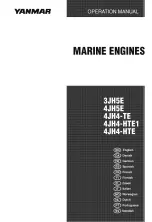
GEN III V8 ENGINE MANAGEMENT
FUEL CONTROL SYSTEM
The purpose of closed loop fuel control is to control
tailpipe emissions consisting of hydrocarbons (HC),
Carbon Monoxide (CO), and Oxides of Nitrogen
(NOx) At the same time, the system must achieve
good engine performance and good fuel economy
The closed loop system regulates exhaust
emissions by controlling the air/fuel ratio at an
optimum level during various driving conditions The
most efficient air/fuel ratio to minimise exhaust
emissions is 1 4 7 to 1 , this allows the 3-way
catalytic converter to operate at maximum efficiency
to control exhaust pollutants Because of the
constant measuring of the exhaust gases by the
oxygen sensors, and adjusting of the fuel injector
pulse width by the PCM, the fuel injection system is
called a closed-loop control system
FUNCTION
The fuel supply system delivers fuel at a regulated
pressure to the fuel rail The fuel injectors, located
directly ahead of each inlet port of the cylinder
head, act as fuel flow control valves, spraying
atomised fuel into the inlet ports when they are
electrically pulsed by the PCM The injectors are
wired individually so they are pulsed individually
This type of fuel injection is referred to as
sequential injection because the injectors are
individually controlled and in a specific order once
every two crankshaft revolutions
The PCM controls the amount of fuel injected into
the engine by controlling the length of time the
injectors are held open This length-of-time is called
pulse width To increase the amount of fuel
injected, the pulse width is lengthened, to decrease
the amount of fuel injected, the pulse width is
shortened
Mass Air Flow System
The Mass Air Flow system is based upon an Air
Flow Meter that measures the mass of the air
entering the engine
Two specific sensors provide the PCM with the
basic information for the fuel management portion
of its operation Engine speed (RPM) from the
crankshaft position signal and the amount of air
entering the engine from the Mass Air Flow (MAF)
sensor
Speed Density System
Three specific sensors provide the PCM with the
basic information for the Speed Density System
Engine speed and air density factors The engine
speed (RPM) comes from the Crankshaft Position
Sensor Air density is derived from IAT and MAP
sensor inputs The IAT sensor measures the air
temperature that is entering the engine The IAT
signal works in conjunction with the MAP sensor to
determine air density As the intake manifold
pressure increases, the air density in the intake
manifold also increases additional fuel is required
This information from the IAT and MAP sensors is
used by the PCM to control injector pulse width
The speed density system is used
• In conjunction with the mass air system to
determine fueling management
• To monitor Mass Air Flow (MAF) sensor
operation (to determine if there is a MAF sensor
malfunction)
• To take over fueling management operation
when there is a Mass Air Flow (MAF) sensor
malfunction
MODES OF OPERATION
Starting Mode
With the ignition switch in the ON position, the PCM
energises the fuel pump relay for two seconds,
allowing the fuel pump to build system pressure
The PCM first checks speed density, then switches
to the Mass Air Flow (MAF) sensor The PCM also
uses the Engine Coolant Temperature (ECT),
Throttle Position (TP), and Manifold Absolute
Pressure (MAP) sensors to determine the proper
air/fuel ratio for starting This ranges from 8.5:1 to
14.7:1 depending on coolant temperature Once the
first crankshaft position signal is received, the PCM
will pulse all of the fuel injectors After the first prime
pulse has been injected, the PCM will wait until it
receives a good camshaft position signal When a
good camshaft position signal is received, the PCM
then operates the fuel injectors in sequential mode
Page - 94 GEN III V8 ENGINE MANAGEMENT
Summary of Contents for GEN III V8
Page 1: ...HOLDEN GEN III V8 ENGINE MANAGEMENT...
Page 3: ......
Page 4: ...GEN III V8 ENGINE MANAGEMENT CONTENTS SUBJECT GEN III V8 ENGINE MANAGEMENT...
Page 5: ...GEN III V8 ENGINE MANAGEMENT NOTES GEN III V8 ENGINE MANAGEMENT...
Page 7: ...GEN III V8 ENGINE MANAGEMENT Page 2 GEN III V8 ENGINE MANAGEMENT...
Page 8: ...GEN III V8 ENGINE MANAGEMENT Page 3...
Page 14: ...GEN III V8 ENGINE MANAGEMENT GEN III V8 ENGINE MANAGEMENT Page 9...
Page 16: ...GEN III V8 ENGINE MANAGEMENT GEN III V8 ENGINE MANAGEMENT Page 1 1...
Page 20: ...GEN III V8 ENGINE MANAGEMENT GEN III V8 ENGINE MANAGEMENT Page 15...
Page 25: ...GEN III V8 ENGINE MANAGEMENT NOTES Page 20 GEN III V8 ENGINE MANAGEMENT...
Page 29: ...GEN III V8 ENGINE MANAGEMENT Paqe 24 GEN III V8 ENGINE MANAGEMENT...
Page 30: ...GEN III V8 ENGINE MANAGEMENT GEN III V8 ENGINE MANAGEMENT Page 25...
Page 31: ...GEN III V8 ENGINE MANAGEMENT Page 26 GEN III V8 ENGINE MANAGEMENT...
Page 72: ...GEN III V8 ENGINE MANAGEMENT GEN III V8 ENGINE MANAGEMENT Page 67...
Page 85: ...GEN III V8 ENGINE MANAGEMENT Page 80 GEN III V8 ENGINE MANAGEMENT...
Page 90: ...GEN III V8 ENGINE MANAGEMENT GEN III V8 ENGINE MANAGEMENT Page 85...
Page 94: ...GEN III V8 ENGINE MANAGEMENT GEN III V8 ENGINE MANAGEMENT Page 89...
Page 104: ...GEN III V8 ENGINE MANAGEMENT GEN III V8 ENGINE MANAGEMENT Page 99...
Page 113: ...GEN III V8 ENGINE MANAGEMENT NOTES Page 108 GEN III V8 ENGINE MANAGEMENT...















































